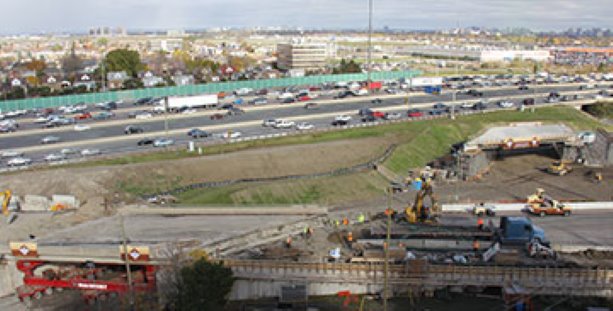While almost an hour past its contracted completion time, a recent weekend-long rapid replacement of the Bridgeland Avenue Bridge in Toronto, by Brennan Paving Limited, was completed with almost no hitches. It was the fifth project of its kind by the Ontario Ministry of Transportation.
But the Nov. 2 to Nov. 5 undertaking was the first in Toronto and occurred just off Highway 401— the nation’s busiest highway — near one of the largest and busiest shopping malls in the country.
For the hundreds of shoppers who flock to the Yorkdale Mall every weekend that meant major detours as both the ramp and the adjacent Bridgeland Avenue were closed from 11 p.m. on Nov. 2 to almost 6 a.m. on Nov. 5.
For the contractor the project required lifting, rotating and removing the old bridge and installing the new 900-ton slab-on-girder bridge in a very confined area, says MTO project manager Raymond Ng.
“They (Brennan) didn’t have a lot of room to work with. It’s quite a tight fit.”
Another complication was the bridge is wider on one end than the other. It expands from two to three lane for traffic heading to the mall and both north and south on Dufferin Street, the main local street, he says.
Placed on the existing abutments, it replaces its 49-year-old predecessor which required extensive rehabilitation.
“But it was determined to be more cost effective to replace the bridge. This was an ideal location to use the innovative rapid bridge replacement technique for the first time in Toronto.”
A comprehensive incident management and traffic plan was developed by the contractor in the lead up to the project.
Those plans included input several parties including the Ontario Provincial Police, Metro Police, Toronto Fire Services, emergency measure services, GO Transit, the Toronto Transit Commission and city officials.
Notices of the closure were placed in local newspapers and on the MTO changeable message signs.
Notices were also hand delivered to local businesses and residents, says Ng.
The project officially began at 11 p.m. on Nov. 2 with the closure of the ramp. For the next several hours Brennan built the new bridge on massive supports erected nearby. Moved to the site on self propelled modular transporters, it was hoisted into place over a two-hour period beginning late night on Nov. 3 and finished early morning on Nov. 4. Because temporary wall barriers and other work had to be completed, it wasn’t open until about 51 minutes later than its scheduled 5 a.m. opening, he says.
Consisting of 10 precast prestressed girders supporting a 225-mm-thick steel reinforced concrete deck slab, the bridge is “a semi integral structure that does not require expansion joints at the deck.”
The old structure, which had been lifted and moved in less than 90 minutes earlier on the afternoon of Nov. 3, will be demolished, says Ng.
Rapid bridge replacement has been used to install three bridges along Highway 417 in Ottawa and on Highway 403 in Hamilton, he says.
“We (MTO) use this method where it makes sense, where it is safe to do so and where it is feasible. It saves time, money, reduces traffic delays and, reduces idling and minimizes impacts to the environment.”



Recent Comments
comments for this post are closed